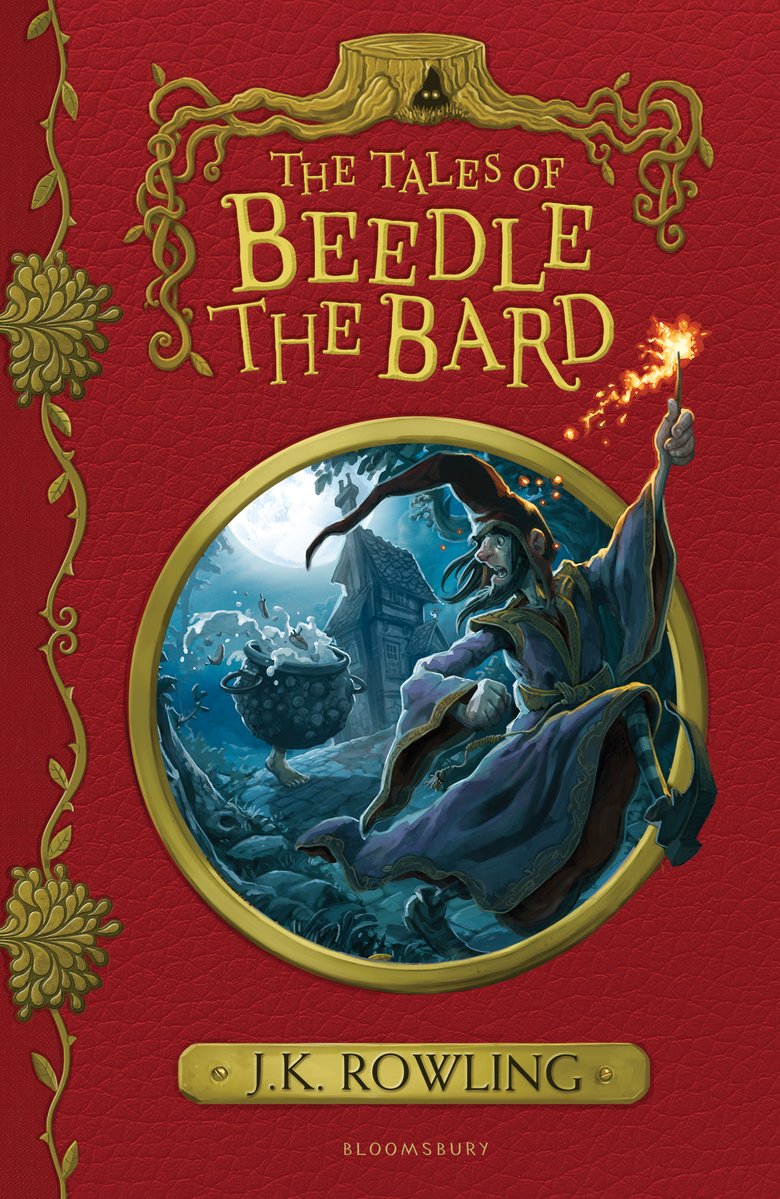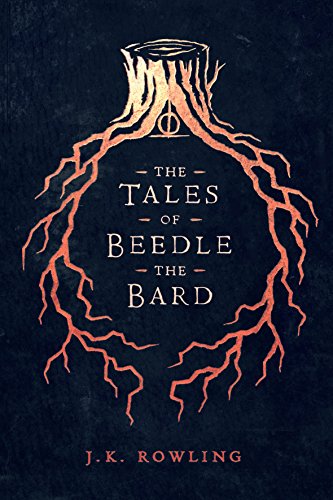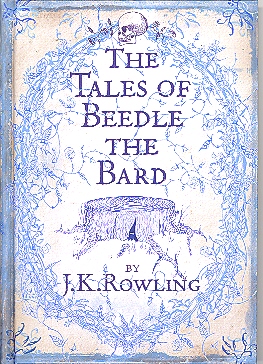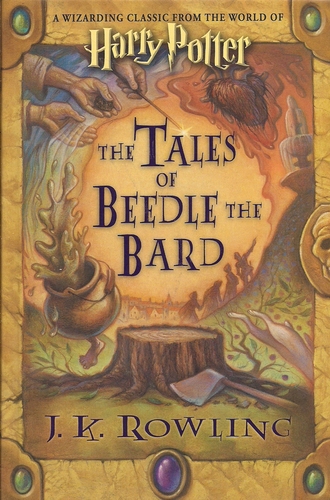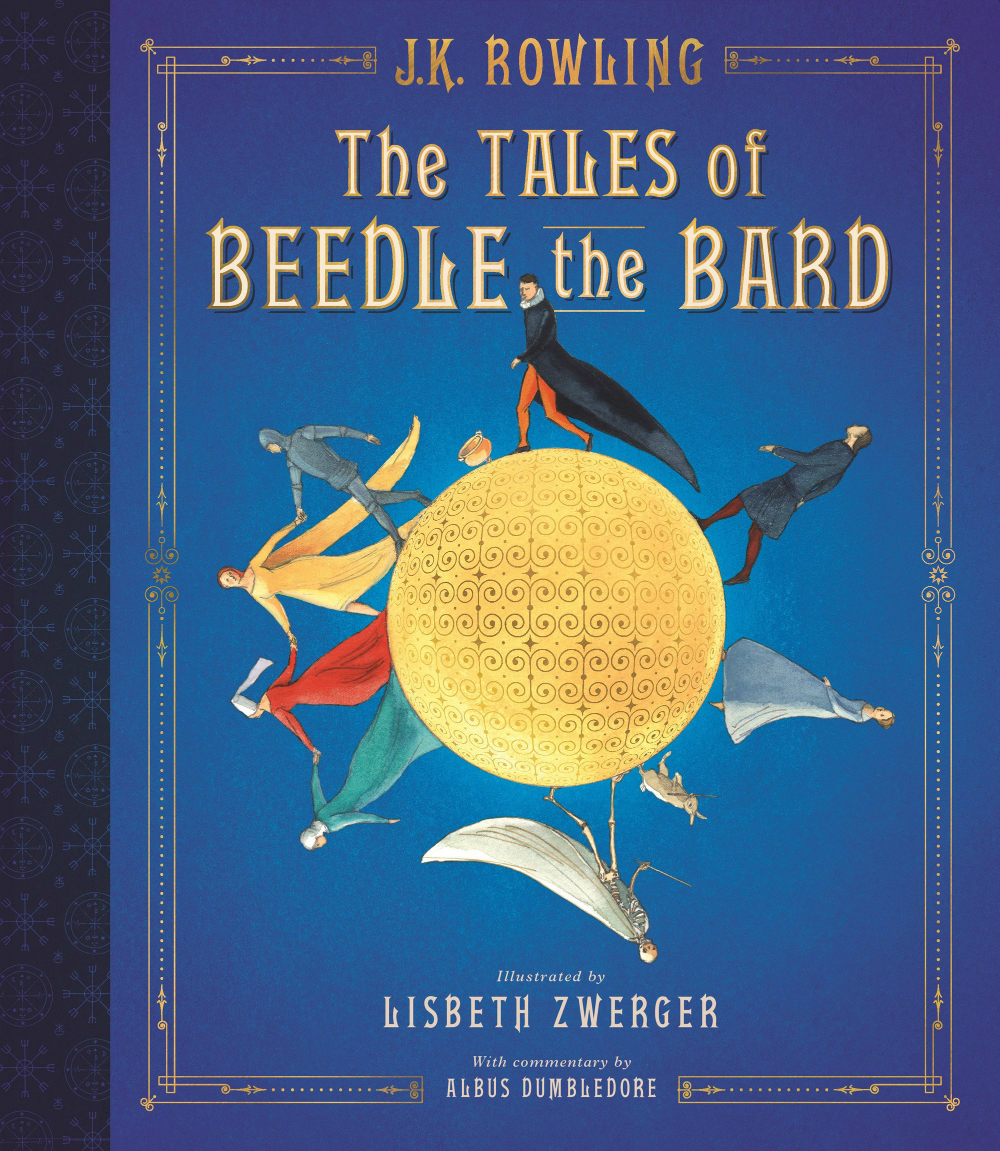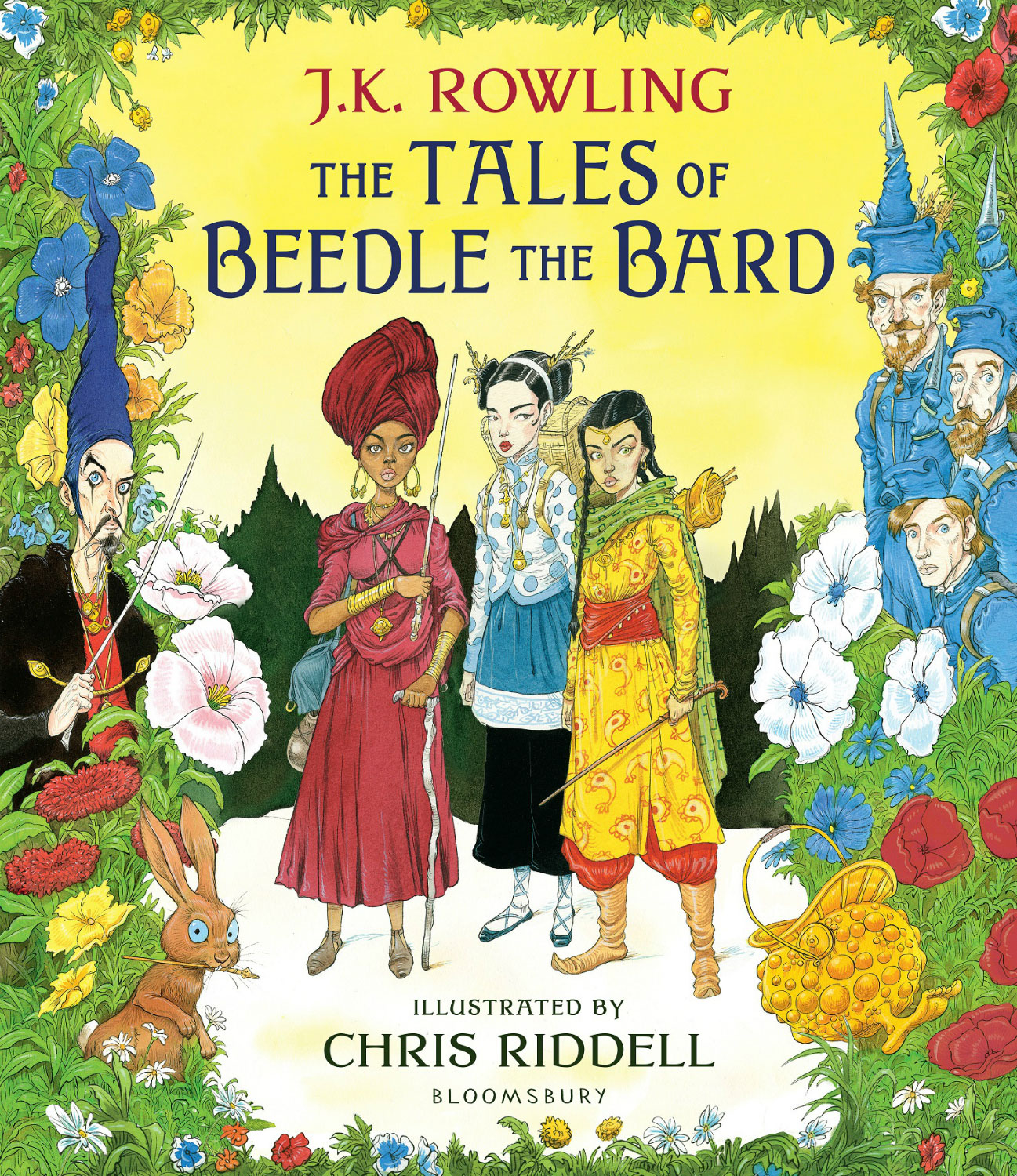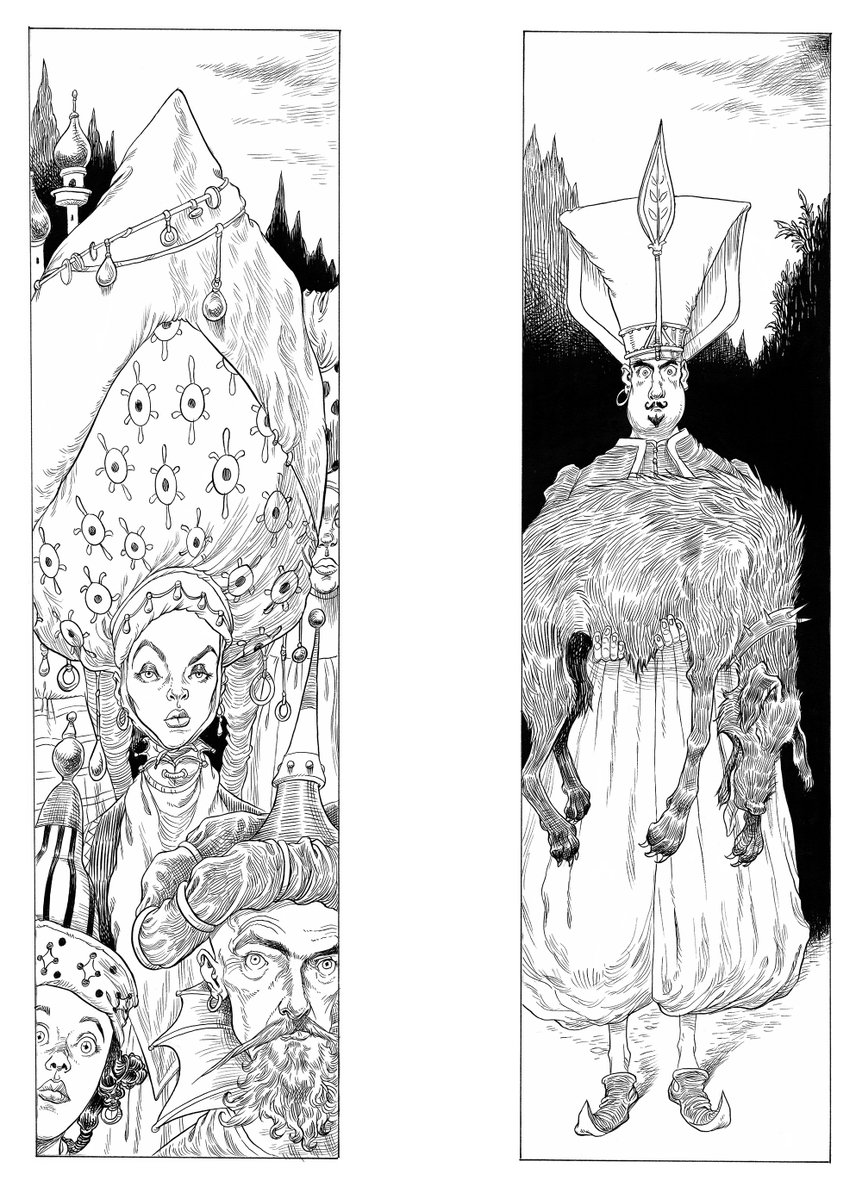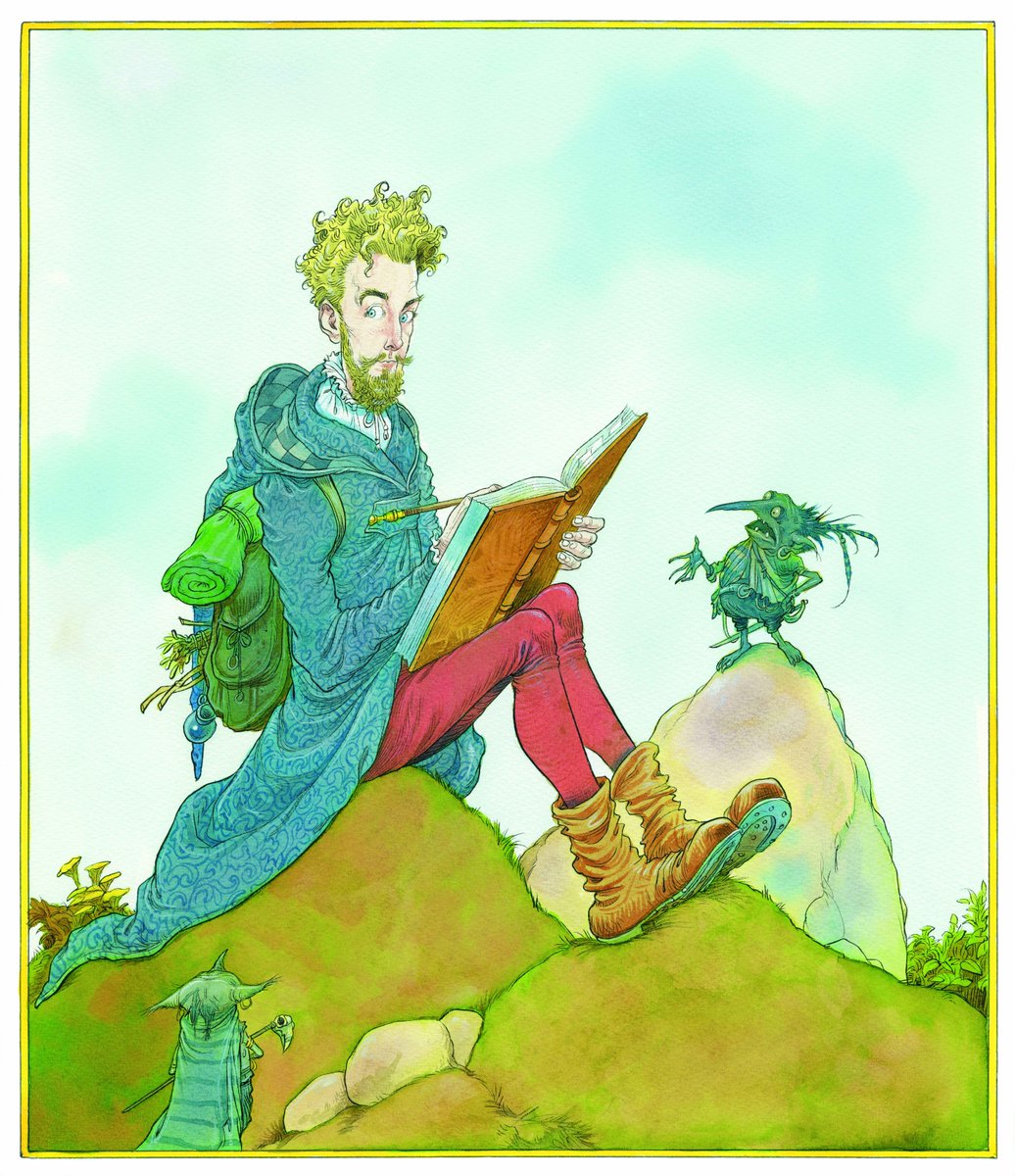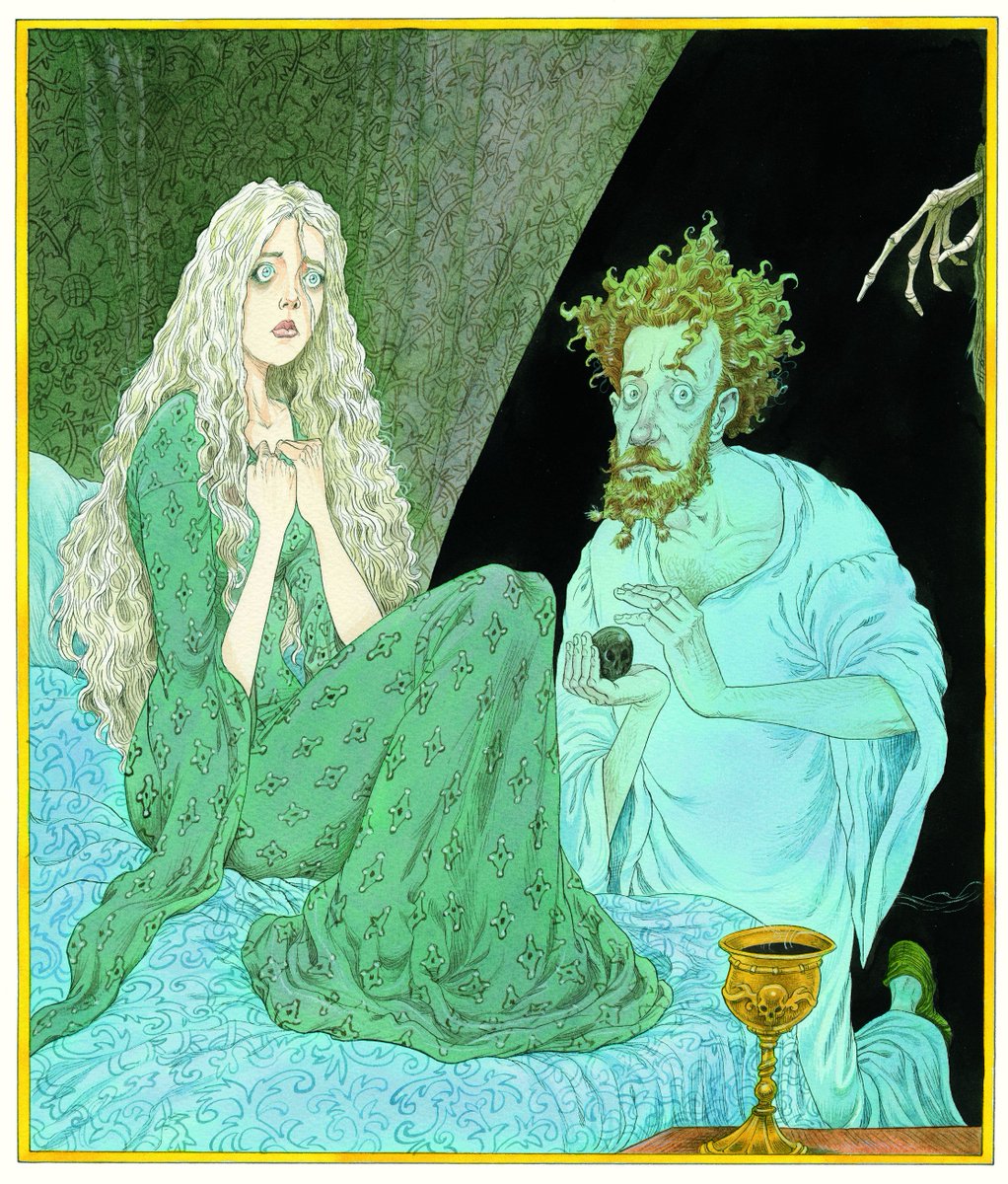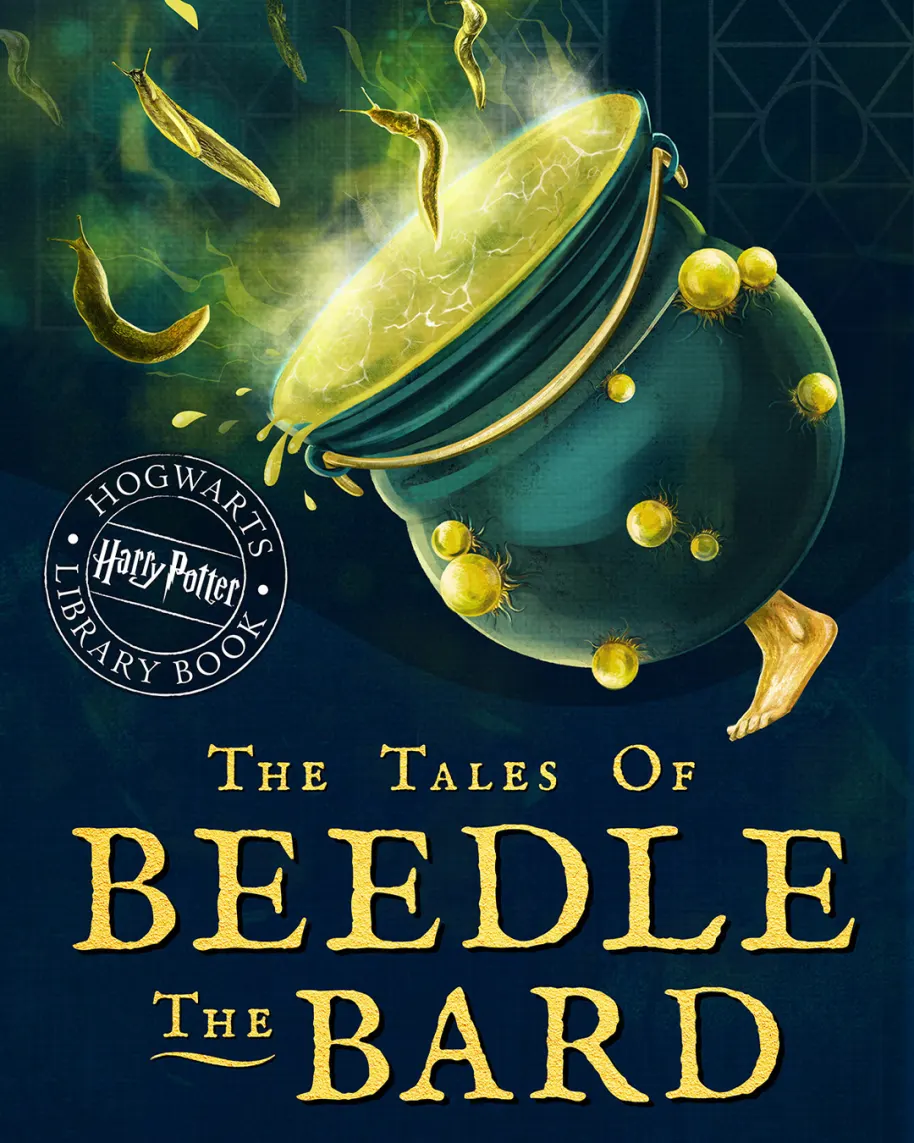Released to the general public on December 4, 2008, The Tales of Beedle the Bard is a book of wizarding children’s stories that serves as a companion book to the Harry Potter series. The book is an essential plot device in Deathly Hallows, with the title of the novel coming from the wizarding fairy tale “The Tale of the Three Brothers.” Hermione Granger inherits Albus Dumbledore’s copy in his will, and wizarding families like the Weasleys grow up on these tales in the same way Muggle children grow up on tales from the Brothers Grimm.
J.K. Rowling started writing the book soon after finishing Deathly Hallows, drawing on other books as sources of inspiration. “The Tale of the Three Brothers,” which is included in its entirety in Deathly Hallows, was inspired by Geoffrey Chaucer’s “The Pardoner’s Tale” from The Canterbury Tales. Proceeds from The Tales of Beedle the Bard benefit Lumos, which aims to end the systematic institutionalization of children.
The Tales of Beedle the Bard, a wizarding classic, first came to Muggle readers’ attention in the book known as Harry Potter and the Deathly Hallows. Now, thanks to Hermione Granger’s new translation from the ancient runes, we present this stunning edition with an introduction, notes, and illustrations by J.K. Rowling, and extensive commentary by Albus Dumbledore. Never before have Muggles been privy to these richly imaginative tales: ‘The Wizard and the Hopping Pot,’ ‘The Fountain of Fair Fortune,’ ‘The Warlock’s Hairy Heart,’ ‘Babbitty Rabbitty and Her Cackling Stump,’ and of course, ‘The Tale of the Three Brothers.’ But not only are they the equal of fairy tales we know and love, reading them gives new insight into the world of Harry Potter.
– Back cover description
- “The Tales of Beedle the Bard” Audiobook Released Today! - Audiobook lovers, rejoice! The brand-new audiobook edition of "The Tales of Beedle the Bard" is available to purchase today!
- UPDATED: Available for Preorder: “The Tales of Beedle the Bard” Audiobook Narrated by Wizarding World Stars - Some of your favorite Wizarding World stars have come together to narrate a magical book...
- “The Tales of Beedle the Bard” Is Among the World’s Most Expensive Books - "The Tales of Beedle the Bard" joins elite company as one of the world's most expensive books.
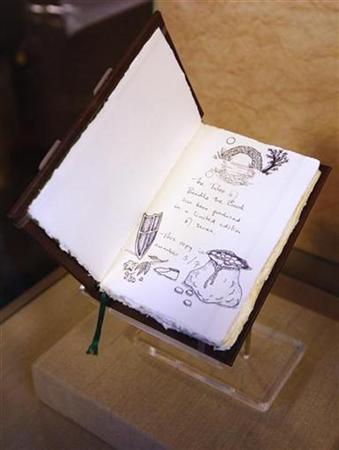
The seventh handwritten copy, the moonstone edition, was offered for auction in late 2007 and was expected to sell for £50,000 (US$103,000, €80,000). Ultimately, it was bought for £1.95 million ($3.98 million, €2.28 million) by Amazon, making the selling price the highest achieved at auction for a modern literary manuscript. The money earned at the auction of the book was donated to Lumos's Children's Voice campaign.
The standard edition includes illustrations reproduced from the original handwritten edition. The limited collector's edition features ten illustrations by Rowling not included in the standard or handcrafted edition, as well as an exclusive reproduction of Rowling's handwritten introduction. Its outer case is disguised as a wizarding textbook from the Hogwarts library and includes a velvet bag embroidered with Rowling's signature, replica gemstones and silver garnishes, and an emerald ribbon. The limited edition retailed for £50 ($100, €100), and around 100,000 copies have been printed.
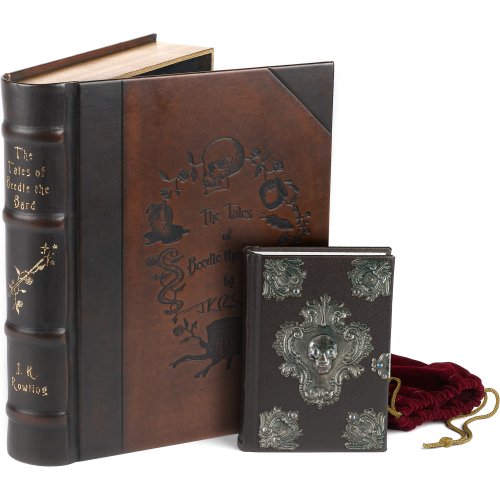
Collector's Edition
"The Wizard and the Hopping Pot"
This tale is about a kind and generous old wizard who uses his magic to come to the aid of his non-magical neighbors and the problems that they would bring to him. He pretends that the solutions to their problems come from what he calls his "lucky cooking pot," and he is genuinely pleased to help them out with their troubles.
After the old wizard dies, he leaves all his possessions to his only son, who has a disposition that is the exact opposite of his father's. The son believes that Muggles are worthless, and it is said that they often quarreled about his father's generous magical aid given to their non-magical neighbors.
The son finds in the cooking pot a small package bearing his name that contains not gold as he was hoping for, but a soft, thick slipper with no pair. A note written on a piece of parchment in the slipper reads, "In the fond hope, my son, that you will never need it."
The son, disgusted with his father, throws the slipper back into the cauldron, vowing to only use it as a rubbish bin. That same night, a peasant woman knocks on the son's door, stating that her daughter has been afflicted by warts and that the son's father used to mix a special poultice to treat them. The son turns down the request for help and slams the door in the woman's face.
Suddenly, he hears loud noises coming from the kitchen. He goes to investigate and sees that his father's cauldron has sprouted a single foot made of brass and is hopping on the floor, contributing to the loud noises he had been hearing. He notices that the surface of the cauldron is covered in warts.
Disgusted, the son tries to use magic to get rid of his father's cauldron. However, none of his spells work. When he goes up to bed, the hopping pot follows him upstairs, leading to a sleepless night for the son due to the loud banging of the pot hopping up and down on the floor all night long.
The next morning, the son hears another knock on the door. An old man on the front doorstep tells the son his donkey is missing. Without the donkey, he cannot bring his items to sell at the market and his family will go hungry. The son yells in the old man's face and slams the door on him.
The father's cauldron continues to hop on its brass foot, but in addition to the clanging noises are added the braying of a donkey and human groans of hunger coming from within the pot. The son again tries using magic to rid himself of the pot or to quiet the noises coming from it, but again, he is unsuccessful.
That evening, there is a third knock on the door. A young woman, sobbing on the front step, says that her baby is seriously ill and that the son's father told her to come if she was troubled. The son slams the door in the young woman's face, and the father's pot fills up with saltwater, spilling tears all over the floor as it continues to hop, bray, and groan all around the house.
Although the villagers stop seeking help from the son, the pot continues to take on the symptoms of all their ills, such as choking and retching, crying like a baby, whining like a dog, and spewing out bad cheese and sour milk as well as a plague of hungry slugs. The son continues to be unable to sleep or eat because of all the noises emanating from the pot, and magic continues to be ineffective in trying to silence it. Finally, the son has had enough.
He runs out of the house with the pot hopping behind him, calling out to all his neighbors to bring their troubles to him so that he could help them. As he runs through the streets, he uses his magic to heal the sickness and sorrow of the villagers, and as he does so, the symptoms emanating from the pot begin to disappear one by one.
When the son turns to the pot after curing the ills of the village, it burps out the single slipper that his father had left him and allows the son to put it on the brass foot. The pot's brass foot muffled at last, the son and the hopping pot head back to the wizard's house.
The story ends by saying that from that day forward, the son helps out his fellow villagers as his father had done before him, lest the pot cast off the slipper and begin to hop once more.
"The Fountain of Fair Fortune"
This is a tale of a magical fountain in the center of a garden surrounded by tall walls. Once a year, the wall opens and pulls one person into the mysterious garden. If that person overcomes the three challenges within the garden, they will be able to bathe in the Fountain of Fair Fortune and will have Fair Fortune forevermore.
In "The Fountain of Fair Fortune," there is a large crowd gathered outside the garden walls. Among the gathering are three witches who share their woes. The three witches agree that if the garden chooses any of them, they will try to stick together.
The first witch, Asha, seeks a cure for her illness. The second witch, Altheda, wants financial security and to be alleviated of poverty. The third witch, Amata, wishes for the fountain to relieve her broken heart.
When the first rays of daylight gleam, the garden wall shifts suddenly; vines sprawl in every direction. A creeper plant ensnares Asha and pulls her into the garden. Asha grabs Altheda, and Altheda grabs Amata. Amata entangles with the armor of a knight, accidentally dragging him with her and the other two witches.
Asha and Altheda are upset with Amata for bringing along the knight since only one person can bathe in the Fountain of Fair Fortune, and the knight will complicate matters. Sir Luckless, the knight, feels very self-conscious and down on his luck. He wants to leave the garden, but Amata insists that he should help protect the witches.
The group of four walk carefree through the enchanted garden until they reach the base of the hill to the fountain. There was a giant worm wrapped around the entire bottom of the slope, blocking their path. At first, the group attempts to defeat the worm with sword and spells. Asha begins to cry as the day wears on, and the worm drinks Asha’s tears and slithers away.
The group then begins to travel up the hill, but words appear on the ground about halfway up. Although the group continues to walk up the incline for several hours, they make no progress. Altheda quickens her pace and encourages the others to do the same. Eventually, she begins to sweat. As the sweat drips onto the ground, the words disappear, and the group starts advancing up the hill.
Soon the group sees the fountain. The fountain is on the hilltop, wholly surrounded by a stream of water. The witches and the knight try various methods of crossing the stream, to no avail. After a while, Amata uses her wand to pull the happy memories of a former lover from her mind and disposes of the memories into the stream. The memories drift away, and stepping stones appear. The group traverses the rocks and walks toward the fountain.
Before they can decide who will bathe in the fountain, Asha becomes very ill and drops to the ground. Asha is in a lot of pain and requests not to be touched. Altheda gathers herbs and mixes them in the knight’s gourd of water. Asha drinks the potion, and her illness immediately disappears. Asha no longer needs the fountain and nominates Altheda to bathe in the magical waters. However, Althelda notices how quickly and efficiently the herbs healed Asha, so she begins to collect more herbs to sell them for a profit. Altheda no longer wants to dip in the fountain and asks Amata to bathe.
Amata no longer wants the fountain to ease her heartache; releasing the memories of her former lover brought her peace. Amata encourages Sir Luckless to bathe in the Fountain of Fair Fortune. Sir Luckless soaks in the waters of the fountain and becomes overjoyed. He throws himself upon Amata's feet and begs for her affection. Amata realizes that Sir Luckless is worthy of her heart.
All four of them link arms, walk down the hill, and leave the garden together. They all have happy and fulfilling lives, never knowing that the Fountain of Fair Fortune possesses no magic at all.
"The Warlock’s Hairy Heart"
This tale highlights a “quest for invulnerability,” a temptation of magic most deep. The narrative follows the journey of a rich and talented warlock who in his youth decides that falling in love makes a fool out of a man and vows never to fall prey to it, employing the Dark Arts to make himself immune to feeling love.
His family holds on to the hope that he will change upon meeting the right maiden, but none catches his fancy even though many do attempt. He becomes so cold that, upon the eventual demise of his parents, he feels relief that he is now the sole occupant of the castle, and his comforts the only priority of his servants. Comfortable in his solitude, he is chagrined to learn that instead of being the object of envy, he is pitied by those around him. His servants wonder why he is unloved and unable to attract a wife despite being wealthy and powerful.
Eager to rectify the situation, he vows to find himself the perfect wife, and as luck would have it, a rich, beautiful, and talented maiden happens upon the town the very next day. The witch, while flattered by his attention, senses the coldness in his heart and is repelled by it. She attends a feast hosted in her honor where she voices her concerns to the warlock, who, to confirm the existence of his heart, leads her to his dungeons, where he stores his greatest treasure.
He had locked away his heart in an enchanted crystal casket, and it has remained untouched throughout the years. His heart has fallen into disuse and is now merely a shrunken hairy remnant of its former glory. Upon the witch’s urging, the warlock replaces the heart in his body, but it has become twisted and savage.
This perverse abomination makes the warlock slaughter the witch, and he attempts to replace his hairy heart with the smooth, scarlet heart belonging to the witch. Unable to overpower the hairy heart with his magic, he cuts open his chest in a mad scramble and collapses dead with a heart held in each hand. The very heart that he did not wish to become enslaved to becomes the cause of his demise.
"Babbitty Rabbitty and Her Cackling Stump"
In this tale, Beedle speaks of a foolish Muggle king who not only fears magic but also covets it. To keep all magic for himself, he commands the formation of a Brigade of Witch-Hunters, a faction of his forces armed with a pack of hounds. The hypocritical king announces far and wide his requirement of a magical instructor, and while no true witch or wizard dares to come forward, a cunning charlatan takes this opportunity to convince the foolish king of his nonexistent magical prowess and secures himself a position as the Grand Sorcerer in Chief.
Being ignorant of the true nature of magic, the king hands over several riches to the charlatan in the name of procuring wands, casting healing charms, and storing magical potions. Unknown to him, old Babbitty, the king’s washerwoman, spies the charlatan snapping two twigs off a tree on the palace grounds. He later passes them off as immensely powerful wands that would only work when the king was deemed worthy.
Weary of practice and insulted by Babbitty’s cackling at his attempts, the king announces that he would perform magic in front of his court the following day and threatens the charlatan with certain death if he either flees the premises or if the king fails and is reduced to a laughing stock. Spying on Babbitty performing real magic, the charlatan sees an out to his dilemma and threatens Babbitty with exposure unless she agrees to anonymously aid the king in his magical display. Conceding to the demands, Babbitty hides behind some shrubbery and performs magic in place of the king.
While she vanishes a hat and levitates a horse successfully, she does not even attempt to resurrect the king’s dead hound, for she knows it to be impossible. To save himself from the king’s wrath at this failed attempt, the charlatan exposes Babbitty as a wicked witch, responsible for blocking the king’s magic.
The Brigade and the hounds hot in pursuit, Babbitty flees the scene and finds refuge in an old crab apple tree. Claiming that Babbitty had turned herself into a tree, the charlatan orders it felled as punishment. Much to everyone’s surprise, the stump begins cackling and speaking in Babbitty’s voice. Taking advantage of the Muggles’ ignorance of magic, Babbitty turns the tables on them, and they eat up the preposterous tales she spins. Using her cunning, Babbitty extracts not only a full confession out of the charlatan but also a promise from the king to never harm wizardkind again.
To make amends, Babbitty demands a statue in her likeness to be erected on the stump, serving as a reminder of the king’s foolishness. The story ends with Babbitty, in the guise of a rabbit, emerging from a hole in the tree stump with a wand clamped between her teeth, hopping away to safety.
"The Tale of the Three Brothers"
Three brothers went to cross a dangerous river, using magic to form a bridge to cross the river safely. Death waited on the bridge to greet the three brothers. Feeling cheated by the brothers’ clever use of magic, he mischievously decided to bestow a gift upon each brother as a reward.
The oldest brother was strong and desired power, so he asked for a wand that could not lose a duel, which he used to kill an enemy. The oldest brother bragged about his powerful wand and how it made him unbeatable. One night, when the oldest brother fell asleep after drinking, an intruder entered his room, stole the wand, and killed him, after which Death came for the oldest brother.
The second brother was heartbroken due to the death of a woman he had once hoped to marry. Angry at Death, he asked for the ability to resurrect people. Death gave him a resurrection stone, which he used to resurrect his former fiancée. Though she was alive in physical form, she was withdrawn and absent emotionally. Overwhelmed with heartbreak and hopelessness, the second brother committed suicide, and so Death came for him too.
The third brother was skeptical about Death’s intentions, so he requested for Death not to follow him. Death reluctantly gave his invisibility cloak to the third brother. Although Death looked for the youngest brother for many years, he could not find him until, when he was elderly, the youngest brother removed the cloak of invisibility and gave it to his son. He welcomed Death as a friend and they departed life together.
The illustrated edition of The Tales of Beedle the Bard was released on October 9, 2018, by Scholastic and on October 2, 2018, by Bloomsbury. Both editions feature color illustrations, Scholastic's by artist Lisbeth Zwerger and Bloomsbury's by artist Chris Riddell, as well as a ribbon marker and illustrated endpapers. The cover of the Scholastic edition depicts the protagonists of each wizarding fairy tale walking around a yellow orb on a blue background, while the cover of the Bloomsbury edition depicts elements of each wizarding fairy tale surrounded by greenery. The Tales of Beedle the Bard marks the first time the Bloomsbury and Scholastic editions had different illustrators.
The Tales of Beedle the Bard audiobook was announced on February 26, 2020, and released on Audible on March 31, 2020. With a runtime of 1 hour and 35 minutes, it is narrated by fan-favorite stars from the Wizarding World. Each star reads an individual story from the pages of the book.
- Albus Dumbledore’s commentary, read by Jude Law (young Albus Dumbledore)
- “The Wizard and the Hopping Pot," read by Warwick Davis (Filius Flitwick)
- "The Tale of the Three Brothers," read by Noma Dumezweni (Hermione Granger in Cursed Child)
- “The Warlock’s Hairy Heart,” read by Jason Isaacs (Lucius Malfoy)
- "The Fountain of Fair Fortune," read by Evanna Lynch (Luna Lovegood)
- “Babbitt Rabbity and Her Cackling Stump,” read by Bonnie Wright (Ginny Weasley)
- J.K. Rowling's introduction, read by Sally Mortemore (Madam Pince)

